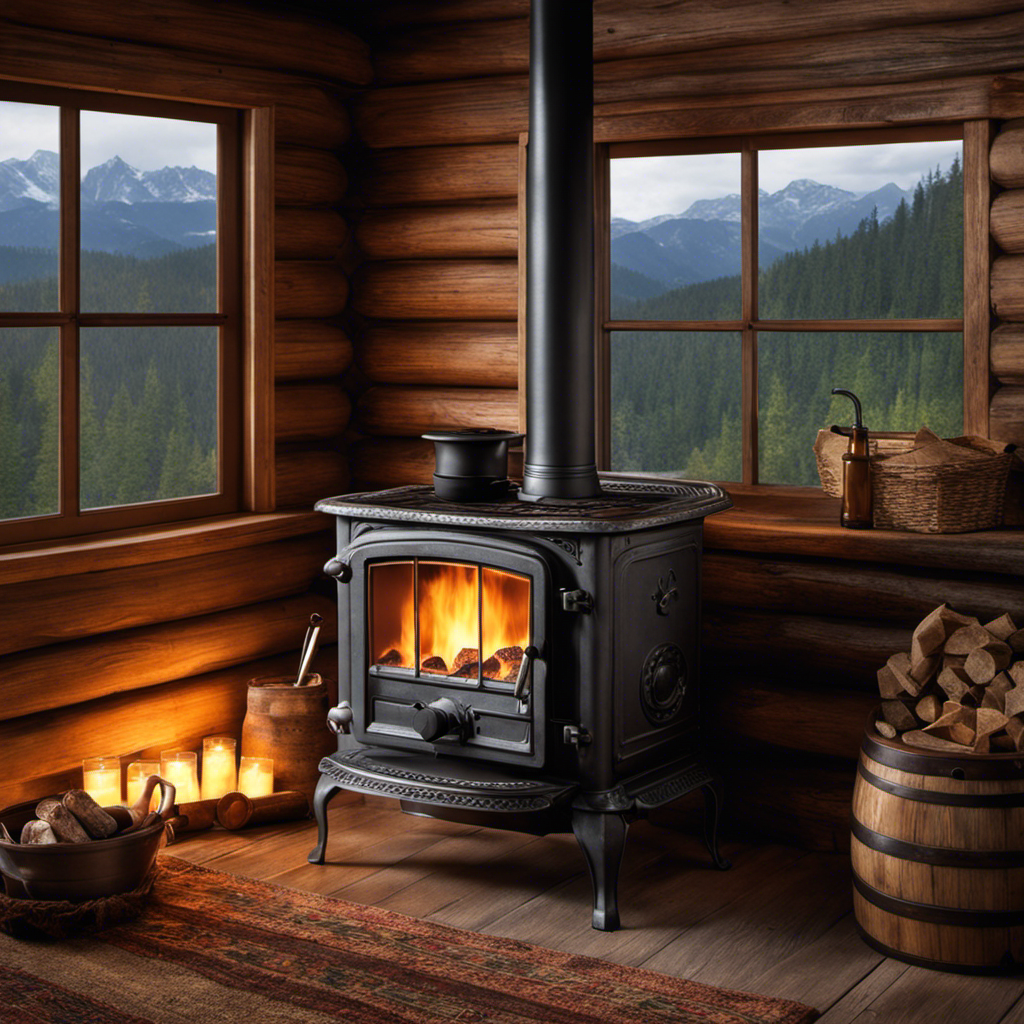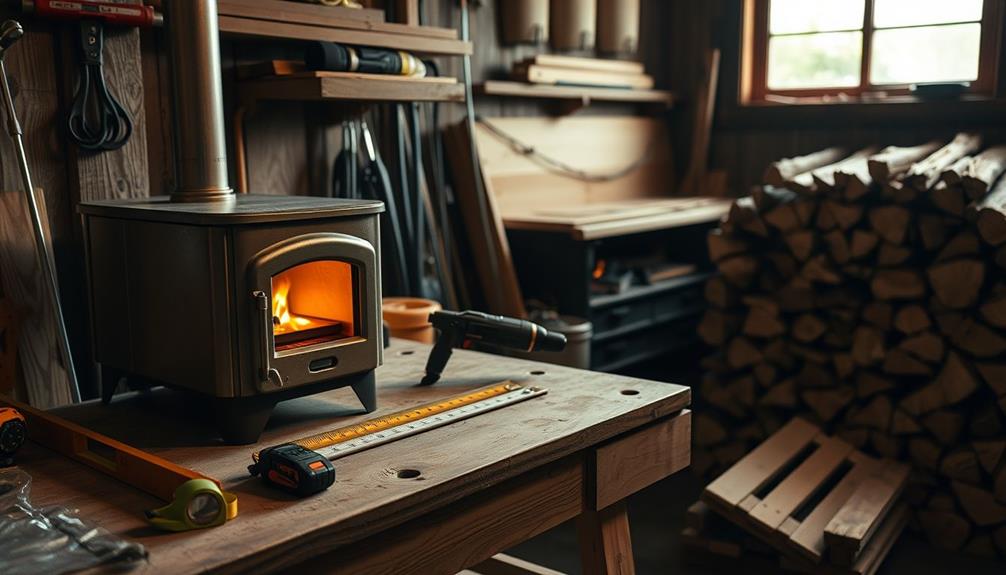I genuinely enjoy making tea on my wood stove with my reliable cast iron tea kettle.
But over time, it has accumulated grime and stubborn stains that need to be cleaned.
That’s why I’m excited to share with you my tried and true methods for effectively cleaning a cast iron tea kettle.
In this article, I’ll provide you with detailed instructions and tips on how to remove residue, stains, and build-up, as well as how to properly maintain and care for your beloved tea kettle.
Let’s get started!
Key Takeaways
- Proper cleaning of a cast iron tea kettle on a wood stove is important to remove built-up residue and maintain the taste of tea.
- Regular cleaning prevents bacterial growth, mineral deposits, and the formation of rust.
- Gentle cleaning methods using warm water and mild dish soap are recommended to avoid damaging the cast iron surface.
- Stubborn stains and build-up can be removed by boiling a mixture of vinegar and water, followed by scrubbing with baking soda and rinsing thoroughly.
Understanding the Importance of Cleaning Your Cast Iron Tea Kettle
I really need to understand the importance of cleaning my cast iron tea kettle.
Cast iron tea kettles have been used for centuries due to their numerous advantages. They distribute heat evenly, retain heat well, and are incredibly durable.
However, they require proper cleaning and maintenance to ensure their longevity. One of the advantages of cleaning your cast iron tea kettle regularly is that it removes any built-up residue or impurities that can affect the taste of your tea.
It also prevents the formation of rust, which can be detrimental to the kettle’s functionality. On the other hand, the disadvantage of neglecting to clean your cast iron tea kettle is the risk of bacterial growth and the accumulation of mineral deposits.
Preparing Your Tea Kettle for Cleaning
Before cleaning, it’s essential to gather all of the necessary tools for preparing your tea kettle. Here are the steps to follow:
-
First, fill a sink or basin with warm water and add a few drops of dish soap. This will create a pre-soaking solution that will help loosen any stubborn residue.
-
Next, carefully remove the tea kettle from the wood stove and place it in the sink or basin. Allow it to soak for about 15-20 minutes to soften any built-up grime.
-
While the kettle is soaking, gather a soft sponge or cloth and a non-abrasive scrub brush. These tools will be used to gently scrub away any remaining dirt or stains.
Once you have gathered all the necessary tools and prepared the pre-soaking solution, you’re ready to tackle the cleaning process. Remember to use gentle scrubbing techniques to avoid damaging the cast iron surface.
Gentle Cleaning Methods for Removing Grime and Residue
Using a soft sponge or cloth, gently scrubbing the cast iron surface will help in removing grime and residue without causing any damage. When it comes to cleaning a cast iron tea kettle that sits on the wood stove, it’s important to use safe cleaning solutions and natural cleaning alternatives.
Harsh chemicals can strip away the seasoning of the cast iron, so it’s best to avoid them. Instead, opt for a mixture of warm water and mild dish soap or a paste made of baking soda and water. These gentle cleaning solutions will effectively remove grime and residue without compromising the integrity of the cast iron.
Once the surface has been scrubbed clean, it’s time to tackle stubborn stains and build-up, which I’ll discuss in the next section.
Effective Techniques for Removing Stubborn Stains and Build-up
To effectively remove stubborn stains and build-up, try using a combination of vinegar and baking soda. This natural cleaning solution is perfect for deep cleaning tasks, like tackling those tough stains on your cast iron tea kettle. Here’s how you can use vinegar and baking soda to get your kettle looking as good as new:
- Begin by filling the kettle with equal parts vinegar and water.
- Place the kettle on the stove and bring the mixture to a boil.
- Let it simmer for about 15 minutes to allow the vinegar to penetrate and loosen the stains.
Next, remove the kettle from the heat and carefully drain the vinegar-water mixture.
- Sprinkle baking soda all over the interior and exterior of the kettle, making sure to cover all stained areas.
- Use a damp cloth or sponge to gently scrub the baking soda into the stains.
Rinse the kettle thoroughly with water until all the baking soda residue is gone.
Proper Maintenance and Care Tips for Your Cast Iron Tea Kettle
I love using my grandmother’s cast iron tea kettle, so I always make sure to follow proper maintenance and care tips to keep it in good condition.
Cast iron tea kettles require regular maintenance to ensure their longevity and optimal performance. One important maintenance tip is to clean the kettle properly after each use. I recommend using warm water and a soft sponge to gently scrub away any residue. Avoid using harsh chemicals or abrasive cleaners, as they can damage the seasoning of the kettle.
Speaking of seasoning, it’s an essential process for maintaining a cast iron tea kettle. Seasoning involves applying a thin layer of oil to the kettle’s interior to prevent rust and enhance its non-stick properties. To season your kettle, simply heat it over low heat and apply a thin layer of oil using a cloth or brush. Allow the oil to penetrate the surface for about 15 minutes, then wipe off any excess.
Frequently Asked Questions
Can I Use Soap to Clean My Cast Iron Tea Kettle?
I wouldn’t recommend using soap to clean a cast iron tea kettle. Instead, try using vinegar, which is a natural and effective cleaner for cast iron. There are also alternative methods for cleaning a cast iron tea kettle.
How Often Should I Clean My Cast Iron Tea Kettle?
I clean my cast iron tea kettle regularly to prevent mineral buildup and ensure a clean taste. Descaling every 1-3 months is recommended. Benefits of using a cast iron tea kettle include even heat distribution and durability.
Can I Use Abrasive Cleaners to Remove Stains From My Cast Iron Tea Kettle?
Yes, you can use abrasive cleaners to remove stains from your cast iron tea kettle. However, I recommend using vinegar for cleaning cast iron instead. It’s a natural and effective alternative method that won’t damage the kettle’s surface.
Can I Clean the Exterior of the Tea Kettle in the Same Way as the Interior?
Yes, you can clean the exterior of the tea kettle in the same way as the interior. Vinegar is a great option for cleaning the exterior, but there are also alternative methods available.
Is It Safe to Use a Wire Brush or Steel Wool to Clean My Cast Iron Tea Kettle?
Yes, it is safe to use a wire brush or steel wool to clean a cast iron tea kettle. However, if you prefer alternative methods, you can also use baking soda or vinegar to remove any rust or stains.
Conclusion
In conclusion, cleaning your cast iron tea kettle is essential for maintaining its beauty and functionality. By following the proper cleaning methods and techniques, you can easily remove grime, stains, and build-up.
Treating your tea kettle with care and regular maintenance will ensure its longevity and optimal performance, just like how a gentle rain showers a garden, refreshing and rejuvenating it.
So, go ahead and give your cast iron tea kettle the attention it deserves and enjoy a delightful cup of tea every time.
Logan’s affair with adventure began in childhood. He hailed from a small town where vast forests bordered one side and endless shores stretched on the other. His days were spent exploring uncharted woods, climbing tall trees, or listening to the tales of old sailors. This early immersion in a world brimming with stories and mysteries became the foundation of his passion for writing.











